Evaluating the Impacts of Alcohol-Based Solutions on Silk: Chemical, Mechanical and Wettability Changes before and after Artificial Ageing
Abstract
1. Introduction
2. Materials and Methods
2.1. Silk Fabrics
2.2. Treatments and Solutions
2.3. Artificial Ageing
- -
- Light. The ageing was carried out by placing the samples in a ventilated chamber (22 ± 5% RH; 20 ± 3 °C) fitted with OSRAM Ultra-Vitalux® solar lamps (300 W, 230 V) providing an illuminance of 12,000 lux (checked with a luxometer Fervi® L014). The lamps emitted in the range between 280 and 2000 nm (13.6 W in the range 315–400 nm, 3.0 W in the range 280–315 nm). The ageing lasted 4 weeks, and samples were monitored every seven days through spectroscopic analyses; colorimetric and wettability measurements; and every fourteen days by tensile testing.
- -
- Medium relative humidity (55% ± 5 RH), through placing the samples in a desiccator with a saturated solution of Mg(NO3)2 [38].
- -
- High relative humidity (80% ± 3 RH), through placing the samples in a desiccator with a saturated solution of KCl [38].
2.4. Analytical Methods
2.4.1. Colorimetric Measurements
2.4.2. Spectroscopic Analyses
2.4.3. Wettability
2.4.4. Tensile Testing
2.4.5. Case Study: Museum of Palazzo Mocenigo
3. Results and Discussion
3.1. Effects of Alcohol-Based Solutions on Silk Samples
3.2. Effects of the Artificial Ageing on the Treated Samples
3.2.1. Light Ageing
3.2.2. Ageing at Medium and High Relative Humidity
3.3. Case Study: Effects of a Museum Environment on the Treated Samples
4. Conclusions
Author Contributions
Funding
Institutional Review Board Statement
Data Availability Statement
Acknowledgments
Conflicts of Interest
References
- Skipper, P.; Fry, C.; Willett, C. Disinfection of Contaminated Heritage Surfaces from SARS-CoV-2 Virus. J. Conserv. Mus. Stud. 2021, 19, 3. [Google Scholar] [CrossRef]
- Favaro, B.; Balliana, E.; Rigoni, F.; Zendri, E. A preliminary evaluation of chemical interaction between sanitizing products and silk. J. Cult. Herit. 2021, 51, 1–13. [Google Scholar] [CrossRef] [PubMed]
- Khlystova, O.; Kalyuzhnova, Y.; Belitski, M. The impact of the COVID-19 pandemic on the creative industries: A literature review and future research agenda. J. Bus. Res. 2022, 139, 1192–1210. [Google Scholar] [CrossRef] [PubMed]
- Choi, B.; Kim, J. Changes and Challenges in Museum Management after the COVID-19 Pandemic. J. Open Innov. Technol. Mark. Complex. 2021, 7, 148. [Google Scholar] [CrossRef]
- Agostino, D.; Arnaboldi, M.; Lampis, A. Italian state museums during the COVID-19 crisis: From onsite closure to online openness. Mus. Manag. Curatorship 2020, 35, 362–372. [Google Scholar] [CrossRef]
- King, E.; Smith, M.P.; Wilson, P.F.; Williams, M.A. Digital Responses of UK Museum Exhibitions to the COVID-19 Crisis, March–June 2020. Curator: Mus. J. 2021, 64, 487–504. [Google Scholar] [CrossRef]
- Lerario, A. Languages and Context Issues of ICTs for a New Role of Museums in the COVID-19 Era. Heritage 2021, 4, 3065–3080. [Google Scholar] [CrossRef]
- Spennemann, D.H.R. COVID-19 on the Ground: Managing the Heritage Sites of a Pandemic. Heritage 2021, 4, 2140–2162. [Google Scholar] [CrossRef]
- MIBACT. Emergenza Epidemiologica da COVID-19—Linee Guida per la Sanificazione in Presenza di beni Culturali ai sensi del D-Lgs. 42/2004 e ss.mm.ii. 2020. Available online: https://www.lazio.beniculturali.it/wp-content/uploads/2020/05/Linee-Guida-ICR.pdf (accessed on 29 August 2022).
- MIBACT; ICR. Allegato def ICR Indicazioni per la Sanificazione in Contesti Culturali. 2020. Available online: http://www.icr.beniculturali.it/documenti/allegati/Allegato%20def%20ICR%20Indicazioni%20per%20la%20sanificazione%20in%20contesti%20culturali%20(4).pdf (accessed on 29 August 2022).
- Golin, A.P.; Choi, D.; Ghahary, A. Hand sanitizers: A review of ingredients, mechanisms of action, modes of delivery, and efficacy against coronaviruses. Am. J. Infect. Control 2020, 48, 1062–1067. [Google Scholar] [CrossRef]
- Singh, D.; Joshi, K.; Samuel, A.; Patra, J.; Mahindroo, N. Alcohol-based hand sanitisers as first line of defence against SARS-CoV-2: A review of biology, chemistry and formulations. Epidemiol. Infect. 2020, 148, e229. [Google Scholar] [CrossRef]
- Ghedini, E.; Pizzolato, M.; Longo, L.; Menegazzo, F.; Zanardo, D.; Signoretto, M. Which Are the Main Surface Disinfection Approaches at the Time of SARS-CoV-2? Front. Chem. Eng. 2021, 2, 1–16. [Google Scholar] [CrossRef]
- Herdt, B.L.; Black, E.P.; Zhou, S.S.; Wilde, C.J. Inactivation of SARS-CoV-2 by 2 commercially available Benzalkonium chloride-based hand sanitizers in comparison with an 80% ethanol-based hand sanitizer. Infect. Prev. Pract. 2021, 3, 100191. [Google Scholar] [CrossRef]
- Kampf, G.; Todt, D.; Pfaender, S.; Steinmann, E. Persistence of coronaviruses on inanimate surfaces and their inactivation with biocidal agents. J. Hosp. Infect. 2020, 104, 246–251. [Google Scholar] [CrossRef] [PubMed]
- Daverey, A.; Dutta, K. COVID-19: Eco-friendly hand hygiene for human and environmental safety. J. Environ. Chem. Eng. 2021, 9, 104754. [Google Scholar] [CrossRef]
- COVID-19: Cleaning and Disinfecting Historic Surfaces. Available online: https://historicengland.org.uk/coronavirus/historic-places/cleaning-disinfecting-historic-surfaces/ (accessed on 29 August 2022).
- Villafana, T. Assessing the Impact of Sanitizing Products on Collection Items. Available online: https://blogs.loc.gov/preservation/2021/06/assessing-the-impact-of-sanitizing-products-on-collection-items/ (accessed on 29 August 2022).
- Luxford, N. Silk durability and degradation. In Understanding and Improving the Durability of Textiles; Annis, P.A., Ed.; Woodhead Publishing: Oxford, UK; Philadelphia, PA, USA, 2012; pp. 205–232. [Google Scholar]
- Vanden Berghe, I. Towards an early warning system for oxidative degradation of protein fibres in historical tapestries by means of calibrated amino acid analysis. J. Archaeol. Sci. 2012, 39, 1349–1359. [Google Scholar] [CrossRef]
- Serrano, A.; Brokerhof, A.; Ankersmit, B.; van Bommel, M. From the bottom of the sea to the display case: A study into the long-term preservation of archaeological maritime silk textiles in controlled atmosphere. J. Cult. Herit. 2020, 45, 91–100. [Google Scholar] [CrossRef]
- Shao, J.; Zheng, J.; Liu, J.; Carr, C.M. Fourier transform Raman and Fourier transform infrared spectroscopy studies of silk fibroin. J. Appl. Polym. Sci. 2005, 96, 1999–2004. [Google Scholar] [CrossRef]
- Timar-Balazsy, A.G.; Eastop, D. Chemical Principles of Textile Conservation; Routledge: London, UK, 1998; p. 480. [Google Scholar] [CrossRef]
- Bratasz, L.; Lukomski, M.; Klisinska-Kopacz, A.; Zawadzki, W.; Dzierzega, K.; Bartosik, M.; Sobczyk, J.; Lennard, F.J.; Kozlowski, R. Risk of Climate-Induced Damage in Historic Textiles. Strain 2015, 51, 78–88. [Google Scholar] [CrossRef]
- Howell, D. Some Mechanical Effects of Inappropriate Humidity on Textiles. In Proceedings of the ICOM Committee for Conservation, 11th Triennial Meeting, Edinburgh, Scotland, 1–6 September 1996; Preprints. Bridgland, J., Ed.; James & James: London, UK, 1996; Volume 2, pp. 692–697. [Google Scholar]
- Vilaplana, F.; Nilsson, J.; Sommer, D.V.P.; Karlsson, S. Analytical markers for silk degradation: Comparing historic silk and silk artificially aged in different environments. Anal. Bioanal. Chem. 2015, 407, 1433–1449. [Google Scholar] [CrossRef]
- Luxford, N.; Thickett, D. Designing accelerated ageing experiments to study silk deterioration in historic houses. J. Inst. Conserv. 2011, 34, 115–127. [Google Scholar] [CrossRef]
- Ballard, M.W. Hanging Out Strength, Elongation and Relative Humidity: Some Physical Properties of Textile Fibers. In Proceedings of the ICOM Committee for Conservation, 11th Triennial Meeting, Edinburgh, Scotland, 1–6 September 1996; Preprints. Bridgland, J., Ed.; James & James: London, UK, 1996; Volume 2, pp. 665–669. [Google Scholar]
- Thickett, D.; Luxford, N.; Lankester, P. Environmental Management Challenges and Strategies in Historic Houses. In Proceedings of the Artifact, Its Context and Their Narrative: Multidisciplinary Conservation in Historic House Museums, Los Angeles, CA, USA, 6–9 November 2012. [Google Scholar]
- Lucero-Gómez, P.; Balliana, E.; Izzo, F.C.; Zendri, E. A new methodology to characterize indoor variations of temperature and relative humidity in historical museum buildings for conservation purposes. Build. Environ. 2020, 185, 107147. [Google Scholar] [CrossRef]
- Macken, A.; Smith, M.J. Solvent Vapour Use—The Unintended Consequences in Textile Conservation. Stud. Conserv. 2019, 64, 352–362. [Google Scholar] [CrossRef]
- Krejčí, J.; Drábková, K.; Bureš Víchová, J.; Škrdlantová, M. Reversibility of adhesive techniques applied on historical textiles. Eur. Phys. J. Plus 2021, 136, 642. [Google Scholar] [CrossRef]
- Drábková, K.; Krejčí, J.; Škrdlantová, M.; Ďurovič, M.; Bacílková, B. Influence of Disinfectants on Natural Textile Fibres. Restaurator. Int. J. Preserv. Libr. Arch. Mater. 2021, 42, 67–86. [Google Scholar] [CrossRef]
- Wang, H.-Y.; Zhang, Y.-Q.; Wei, Z.-G. Dissolution and processing of silk fibroin for materials science. Crit. Rev. Biotechnol. 2021, 41, 406–424. [Google Scholar] [CrossRef] [PubMed]
- Minoura, N.; Tsukada, M.; Nagura, M. Fine structure and oxygen permeability of silk fibroin membrane treated with methanol. Polymer 1990, 31, 265–269. [Google Scholar] [CrossRef]
- Kaewpirom, S.; Boonsang, S. Influence of alcohol treatments on properties of silk-fibroin-based films for highly optically transparent coating applications. RSC Adv. 2020, 10, 15913–15923. [Google Scholar] [CrossRef] [PubMed]
- Bucciarelli, A.; Motta, A. Use of Bombyx mori silk fibroin in tissue engineering: From cocoons to medical devices, challenges, and future perspectives. Biomater. Adv. 2022, 139, 1–29. [Google Scholar] [CrossRef]
- ISO 12571:2021; Hygrothermal Performance of Building Materials and Products—Determination of Hygroscopic Sorption Properties. CEN-CENELEC Management Centre: Brussels, Belgium, 2021.
- Luxford, N.; Thickett, D.; Wyeth, P. Applying preventive conservation recommendations for silk in historic houses. In Proceedings of the Joint Interim Conference. Multidisciplinary Conservation: A Holistic View for Historic Interiors, Rome, Italy, 23–26 March 2010. [Google Scholar]
- Izzo, F.C.; Balliana, E.; Perra, E.; Zendri, E. Accelerated Ageing Procedures to Assess the Stability of an Unconventional Acrylic-Wax Polymeric Emulsion for Contemporary Art. Polymers 2020, 12, 1925. [Google Scholar] [CrossRef]
- Zendri, E.; Falchi, L.; Izzo, F.C.; Morabito, Z.M.; Driussi, G. A review of common NDTs in the monitoring and preservation of historical architectural surfaces. Int. J. Archit. Herit. 2017, 11, 987–1004. [Google Scholar] [CrossRef]
- Zhang, X.; Gong, D.; Gong, Y. Insight into the orientation behavior of thermal-aged and historic silk fabrics by polarized FTIR microspectroscopy. J. Cult. Herit. 2019, 38, 53–63. [Google Scholar] [CrossRef]
- McGill, M.; Holland, G.P.; Kaplan, D.L. Experimental Methods for Characterizing the Secondary Structure and Thermal Properties of Silk Proteins. Macromol. Rapid Commun. 2019, 40, 1800390. [Google Scholar] [CrossRef]
- Kissi, N.; Curran, K.; Vlachou-Mogire, C.; Fearn, T.; McCullough, L. Developing a non-invasive tool to assess the impact of oxidation on the structural integrity of historic wool in Tudor tapestries. Herit. Sci. 2017, 5, 49. [Google Scholar] [CrossRef]
- Richardson, E.; Garside, P. The use of near infrared spectroscopy as a diagnostic tool for historic silk artefacts. J. E-Preserv. Sci. 2009, 6, 68–74. [Google Scholar]
- UNI EN 15802: 2010; Conservation of Cultural Property—Test Methods—Determination of Static Contact Angle. CEN-CENELEC Management Centre: Brussels, Belgium, 2010.
- BS EN ISO 13934-1:2013; Textiles—Tensile Properties of Fabrics—Part 1: Determination of Maximum Force and Elongation at Maximum Force Using the Strip Method. ISO/TC 38/SC 24 AFNOR: Paris, France, 2013.
- Young, C.; Jardine, S. Fabrics for the twenty-first century: As artist canvas and for the structural reinforcement of easel paintings on canvas. Stud. Conserv. 2012, 57, 237–253. [Google Scholar] [CrossRef]
- Smith, M.J.; Flowers, T.H.; Lennard, F.J. Mechanical properties of wool and cotton yarns used in twenty-first century tapestry: Preparing for the future by understanding the present. Stud. Conserv. 2015, 60, 375–383. [Google Scholar] [CrossRef]
- Edwards, H.G.M.; Farwell, D.W. Raman spectroscopic studies of silk. J. Raman Spectrosc. 1995, 26, 901–909. [Google Scholar] [CrossRef]
- Pereira, R.F.P.; Silva, M.M.; de Zea Bermudez, V. Bombyx mori Silk Fibers: An Outstanding Family of Materials. Macromol. Mater. Eng. 2015, 300, 1171–1198. [Google Scholar] [CrossRef]
- Garside, P.; Wyeth, P.; Zhang, X. Use of near IR spectroscopy and chemo-metrics to assess the tensile strength of historic silk. E-Preserv. Sci. 2011, 8, 68–73. [Google Scholar]
- Liu, D.; Christe, D.; Shakibajahromi, B.; Knittel, C.; Castaneda, N.; Breen, D.; Dion, G.; Kontsos, A. On the role of material architecture in the mechanical behavior of knitted textiles. Int. J. Solids Struct. 2017, 109, 101–111. [Google Scholar] [CrossRef]
- Schramm, L.L.; Stasiuk, E.N.; Marangoni, D.G. 2 Surfactants and their applications. Annu. Rep. Sect. C Phys. Chem. 2003, 99, 3–48. [Google Scholar] [CrossRef]
- Koperska, M.A.; Łojewski, T.; Łojewska, J. Evaluating degradation of silk’s fibroin by attenuated total reflectance infrared spectroscopy: Case study of ancient banners from Polish collections. Spectrochim. Acta Part A Mol. Biomol. Spectrosc. 2015, 135, 576–582. [Google Scholar] [CrossRef] [PubMed]
- Koperska, M.A.; Pawcenis, D.; Milczarek, J.M.; Blachecki, A.; Łojewski, T.; Łojewska, J. Fibroin degradation—Critical evaluation of conventional analytical methods. Polym. Degrad. Stab. 2015, 120, 357–367. [Google Scholar] [CrossRef]
- Uring, P.; Chabas, A.; Alfaro, S.C. Textile ageing due to atmospheric gases and particles in indoor cultural heritage. Environ. Sci. Pollut. Res. 2021, 28, 66340–66354. [Google Scholar] [CrossRef]
- Sabatini, F.; Nacci, T.; Degano, I.; Colombini, M.P. Investigating the composition and degradation of wool through EGA/MS and Py-GC/MS. J. Anal. Appl. Pyrolysis 2018, 135, 111–121. [Google Scholar] [CrossRef]
- Zhang, X.; Wyeth, P. Moisture Sorption as a Potential Condition Marker for Historic Silks: Noninvasive Determination by Near-Infrared Spectroscopy. Appl. Spectrosc. 2007, 61, 218–222. [Google Scholar] [CrossRef]
- Lucero-Gómez, P.; Balliana, E.; Farinelli, V.; Salvini, S.; Signorelli, L.; Zendri, E. Rethinking and evaluating the role of historical buildings in the preservation of fragile artworks: The case study of the Gallerie dell’Accademia in Venice. Eur. Phys. J. Plus 2022, 137, 150. [Google Scholar] [CrossRef]
- Cuttle, C. Control of damage to museum objects by exposure to optical radiation. In Proceedings of the 24th Session of the CIE, Warsaw, Poland, 24–30 June 1999; Volume 1, pp. 324–328. [Google Scholar]
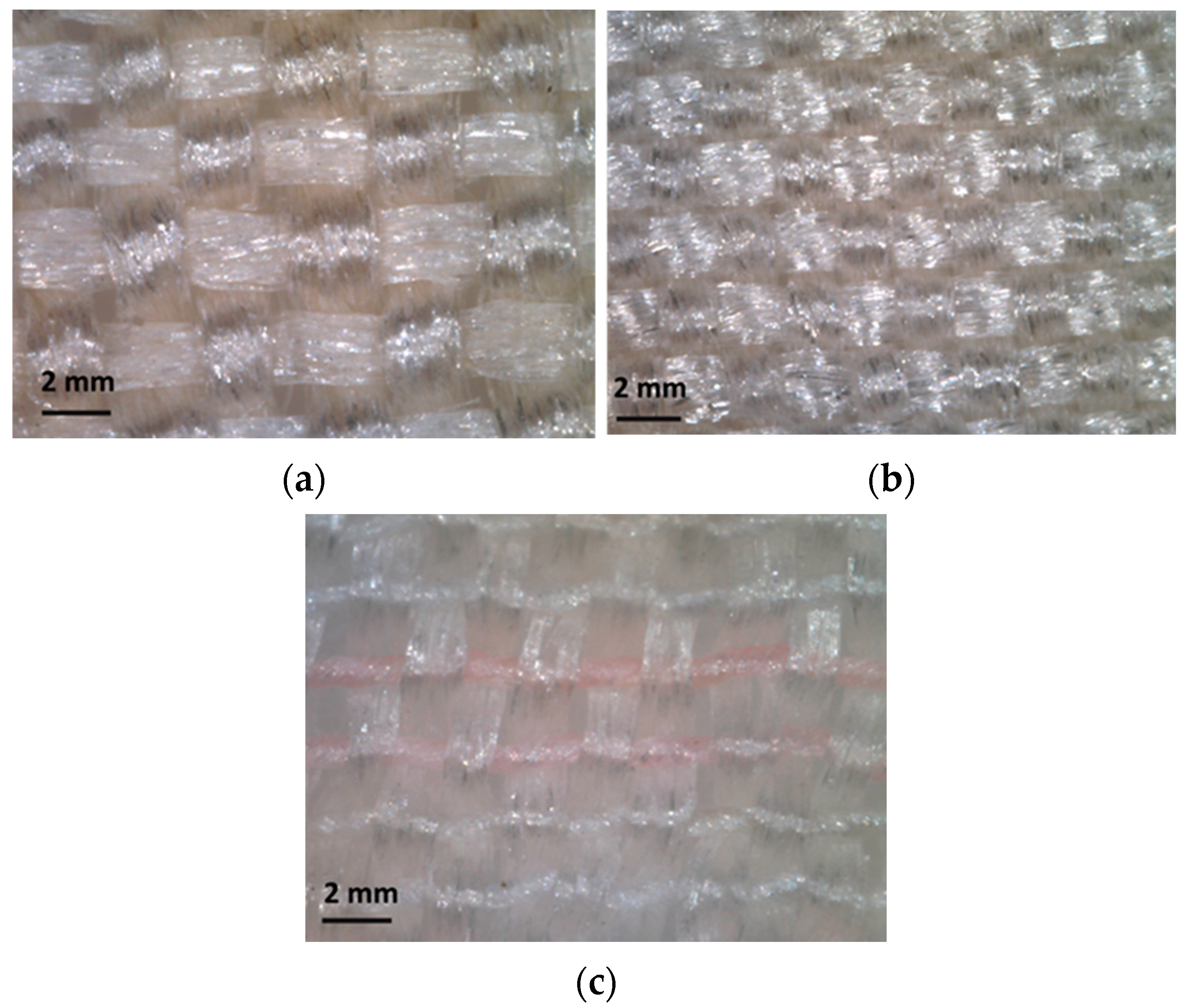

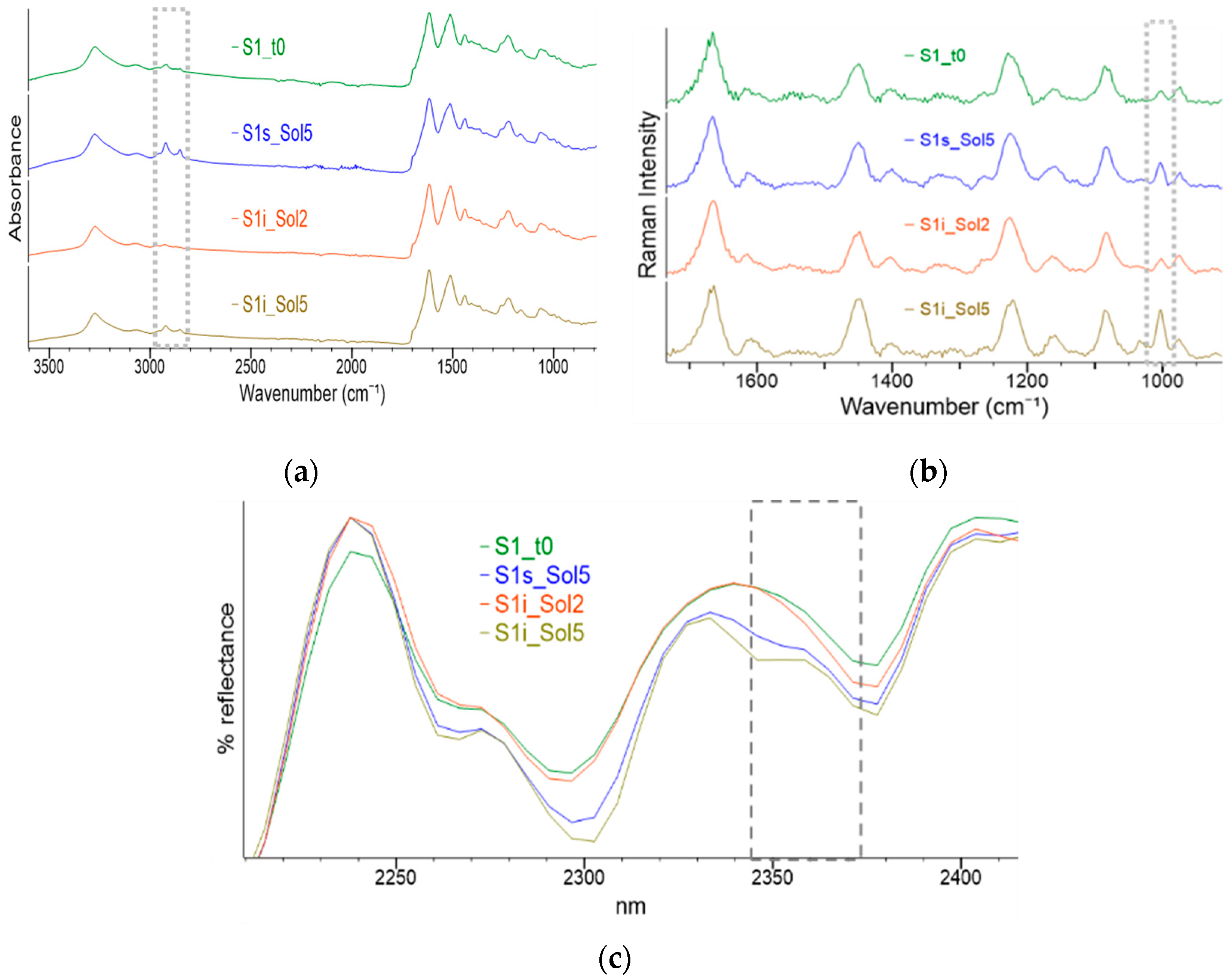
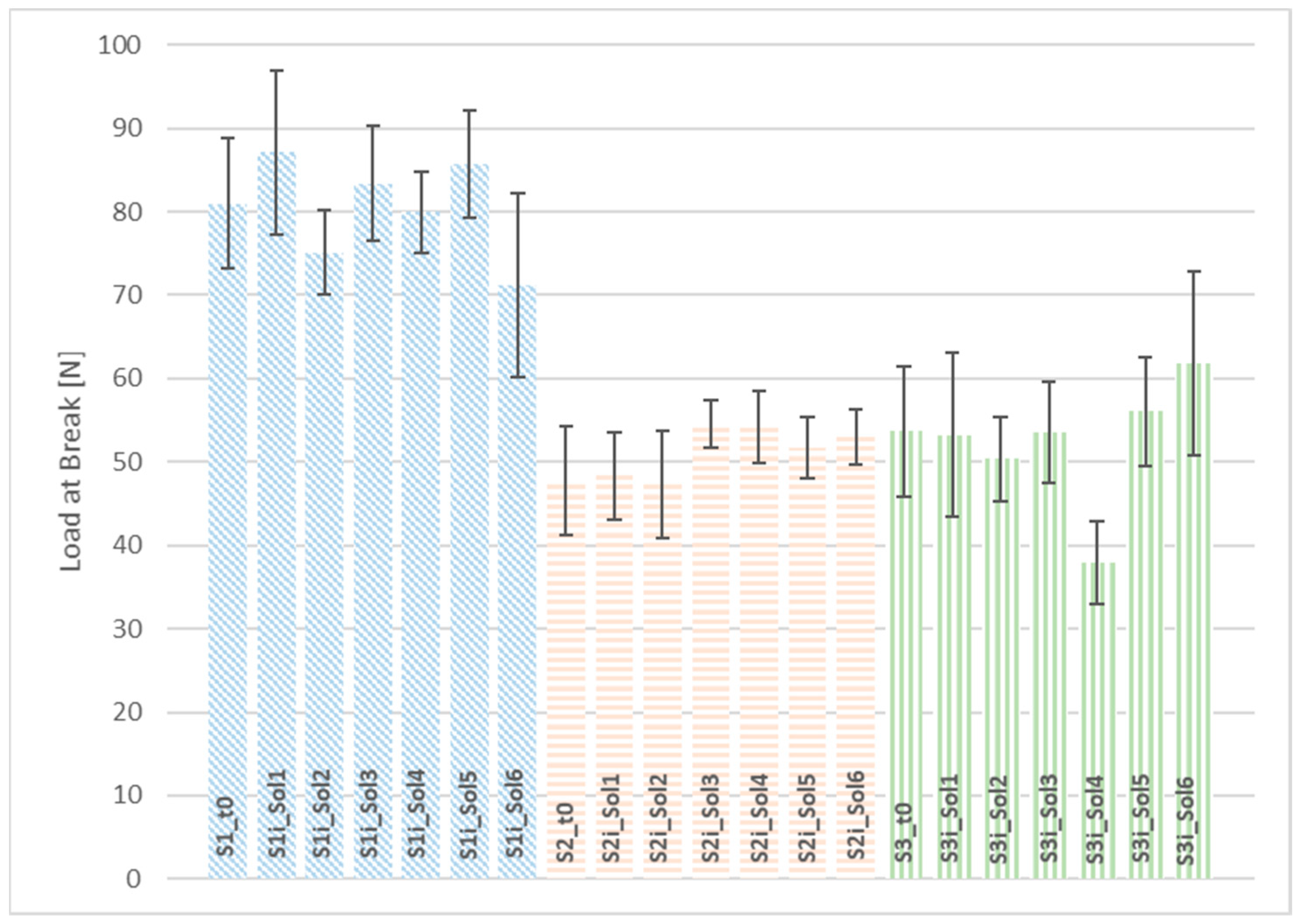
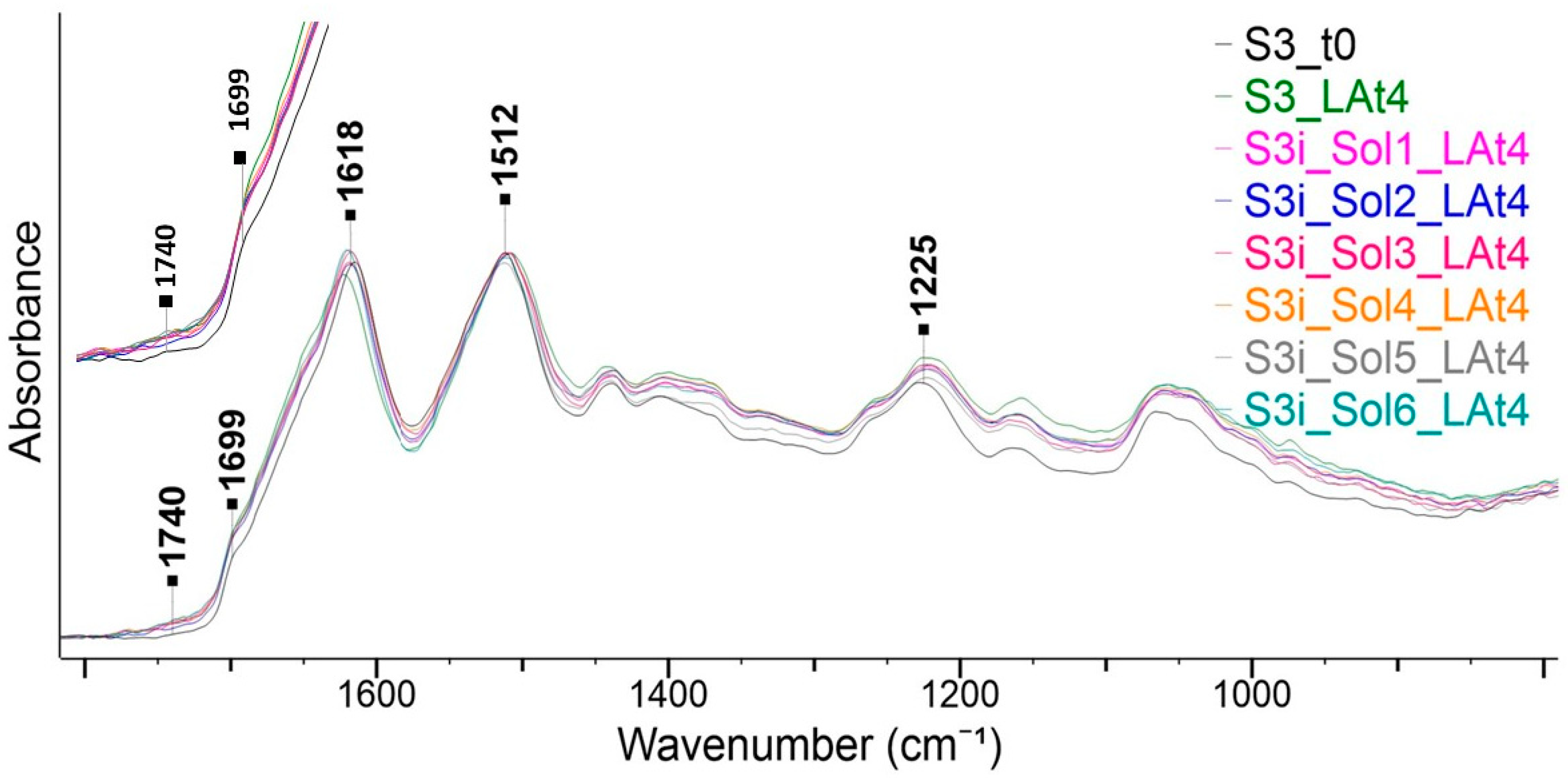
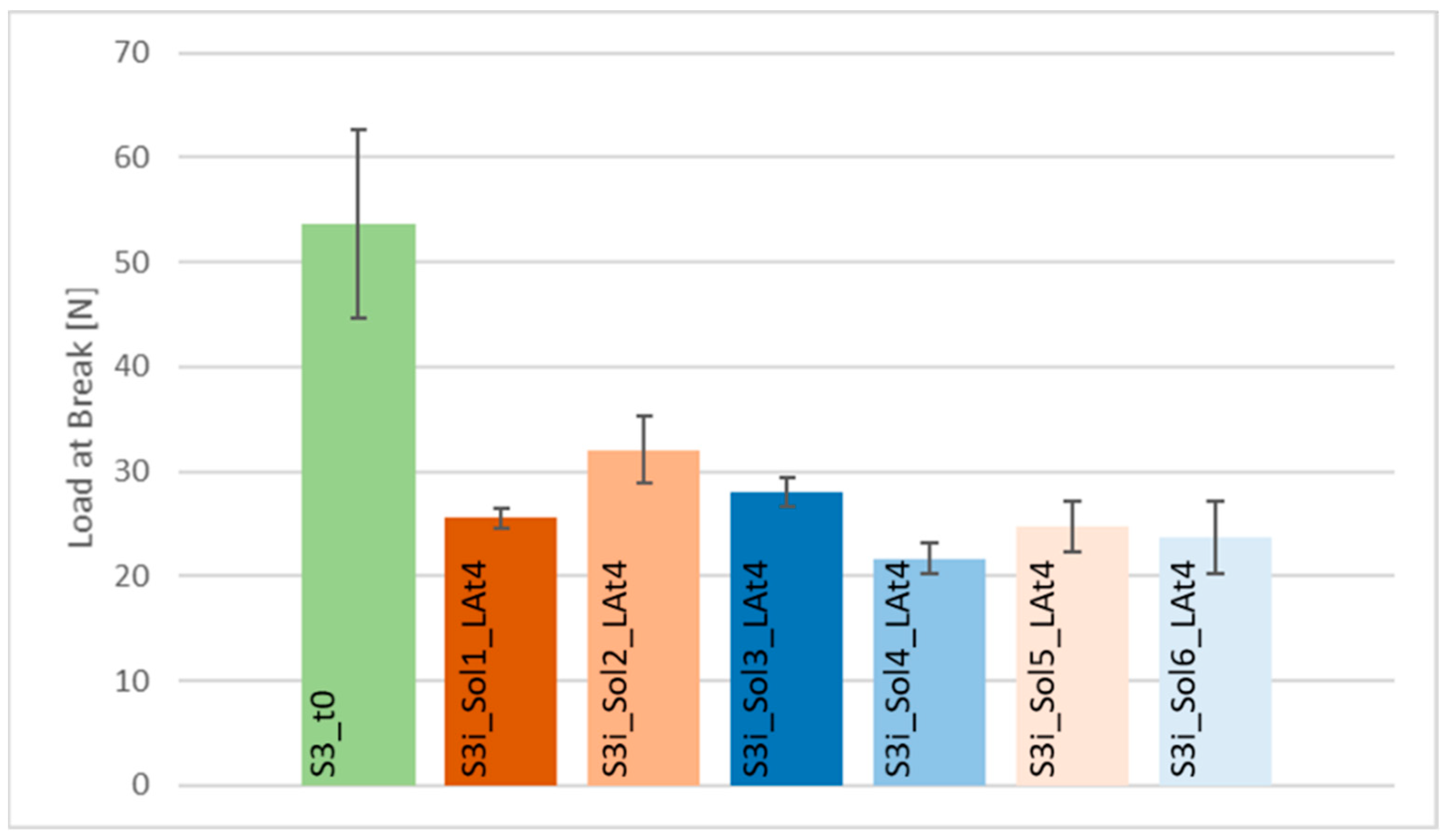
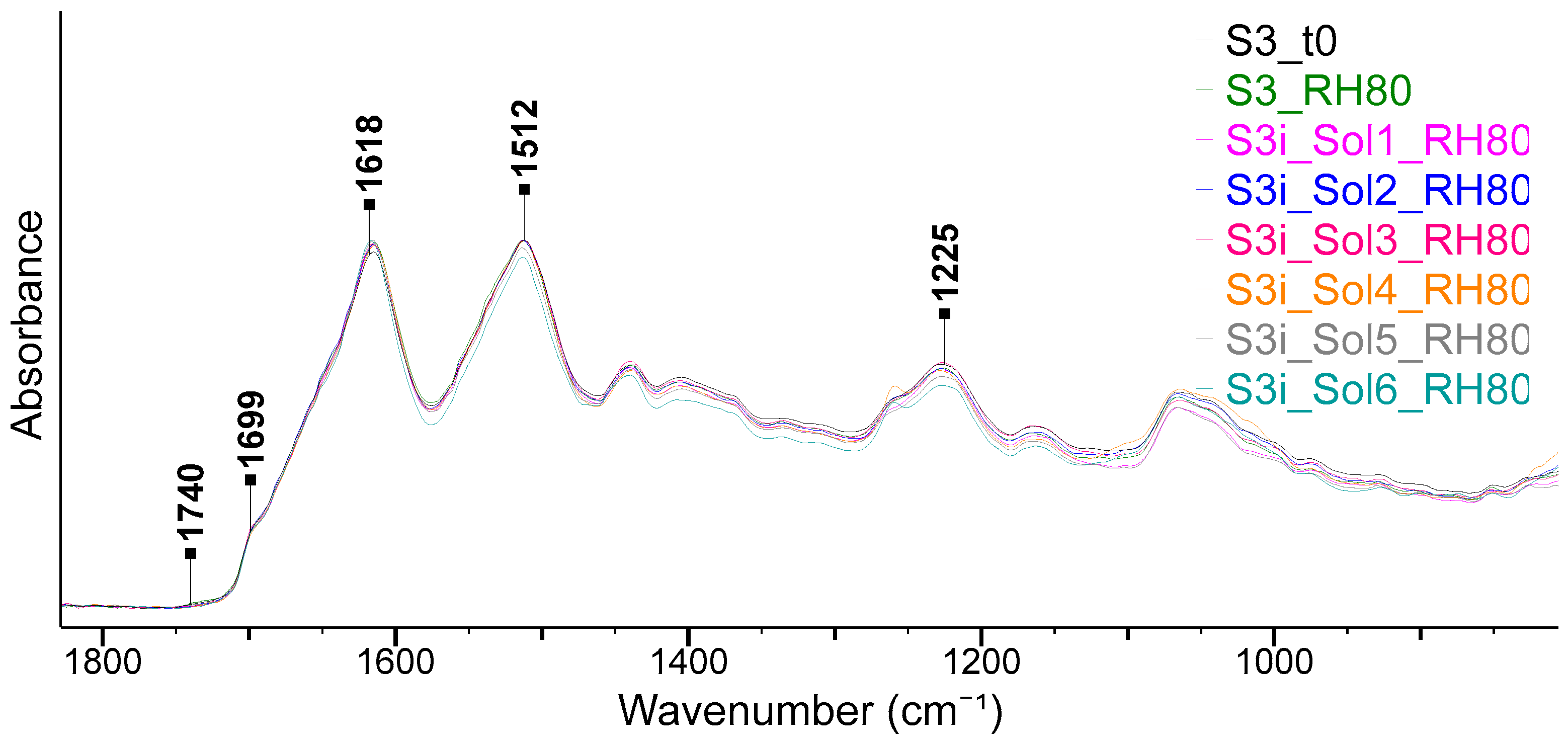
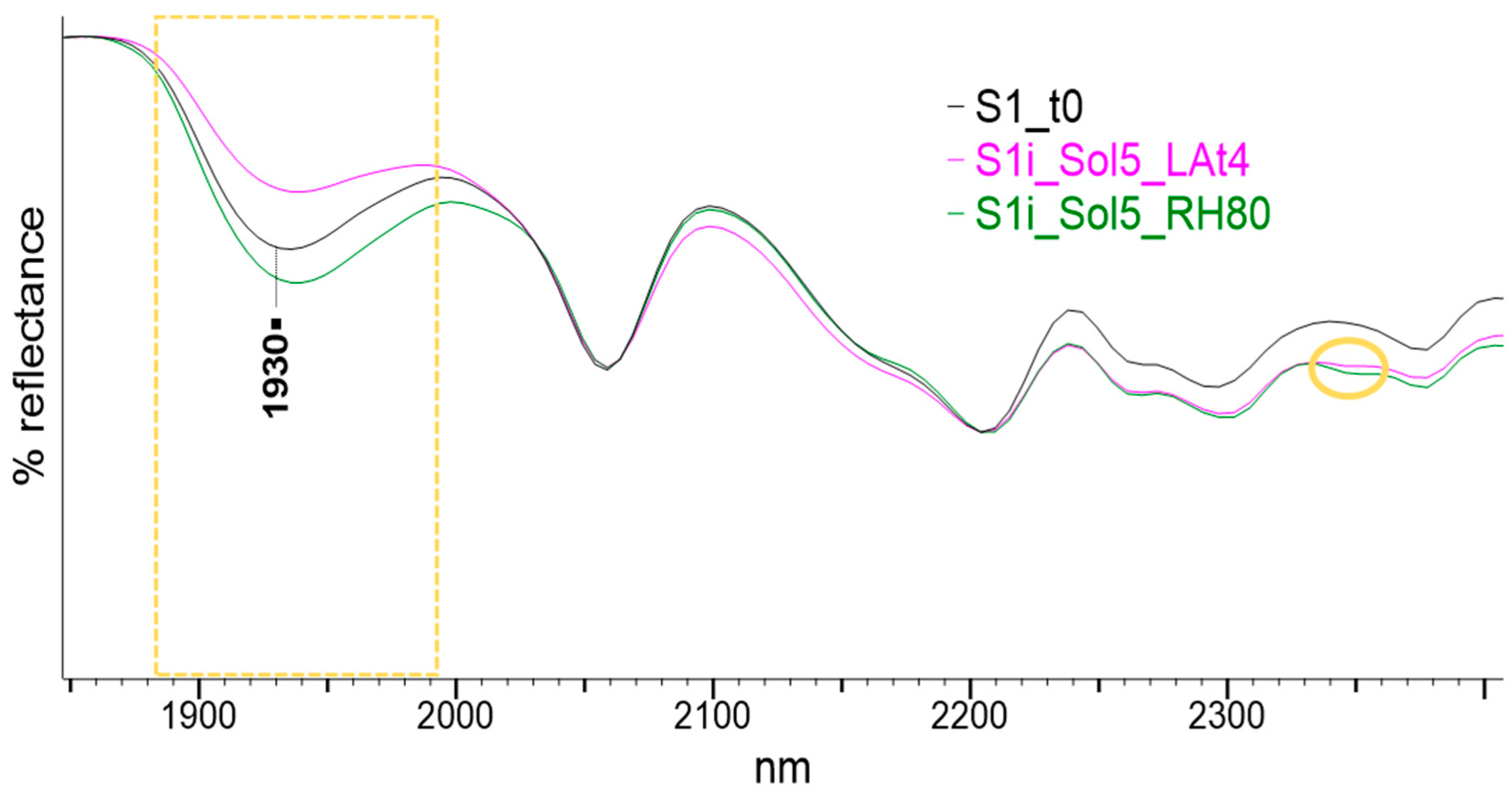
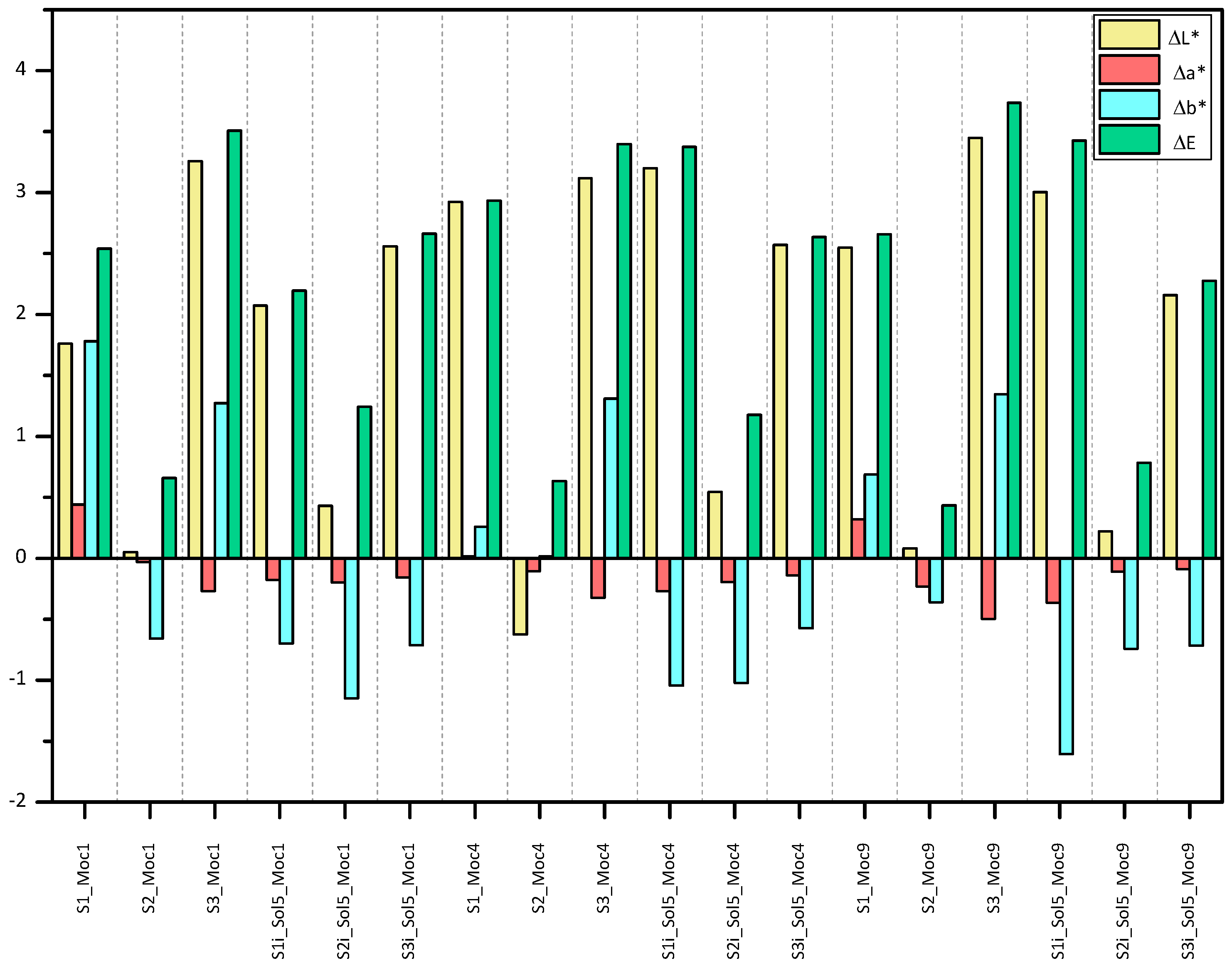
| Treatment | Sol. 1 | Sol. 2 | Sol. 3 | Sol. 4 | Sol. 5 | Sol. 6 |
|---|---|---|---|---|---|---|
| Immersion | S1/i_Sol1 | S1/i_Sol2 | S1/i_Sol3 | S1/i_Sol4 | S1/i_Sol5 | S1/i_Sol6 |
| Spraying | S1/s_Sol1 | S1/s_Sol2 | S1/s_Sol3 | S1/s_Sol4 | S1/s_Sol5 | S1/s_Sol6 |
Publisher’s Note: MDPI stays neutral with regard to jurisdictional claims in published maps and institutional affiliations. |
© 2022 by the authors. Licensee MDPI, Basel, Switzerland. This article is an open access article distributed under the terms and conditions of the Creative Commons Attribution (CC BY) license (https://creativecommons.org/licenses/by/4.0/).
Share and Cite
Costantini, R.; Balliana, E.; Dalla Torre, D.; Aricò, F.; Zendri, E. Evaluating the Impacts of Alcohol-Based Solutions on Silk: Chemical, Mechanical and Wettability Changes before and after Artificial Ageing. Heritage 2022, 5, 3588-3604. https://doi.org/10.3390/heritage5040186
Costantini R, Balliana E, Dalla Torre D, Aricò F, Zendri E. Evaluating the Impacts of Alcohol-Based Solutions on Silk: Chemical, Mechanical and Wettability Changes before and after Artificial Ageing. Heritage. 2022; 5(4):3588-3604. https://doi.org/10.3390/heritage5040186
Chicago/Turabian StyleCostantini, Rosa, Eleonora Balliana, Davide Dalla Torre, Fabio Aricò, and Elisabetta Zendri. 2022. "Evaluating the Impacts of Alcohol-Based Solutions on Silk: Chemical, Mechanical and Wettability Changes before and after Artificial Ageing" Heritage 5, no. 4: 3588-3604. https://doi.org/10.3390/heritage5040186
APA StyleCostantini, R., Balliana, E., Dalla Torre, D., Aricò, F., & Zendri, E. (2022). Evaluating the Impacts of Alcohol-Based Solutions on Silk: Chemical, Mechanical and Wettability Changes before and after Artificial Ageing. Heritage, 5(4), 3588-3604. https://doi.org/10.3390/heritage5040186









